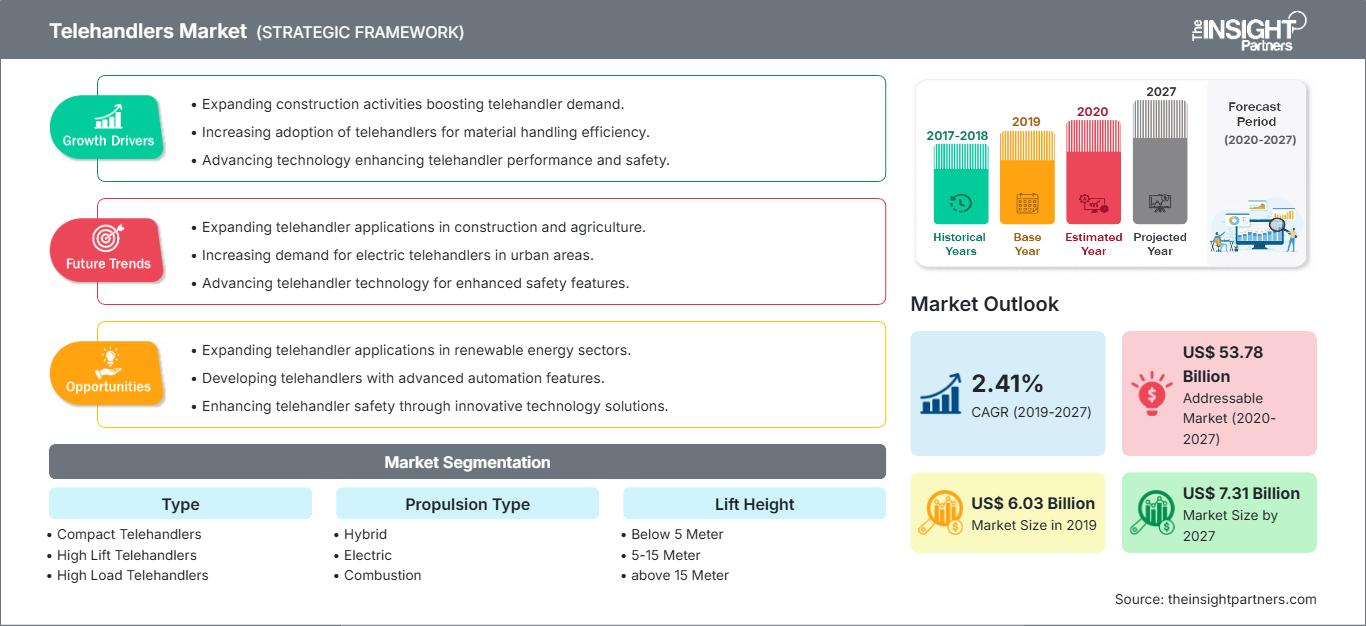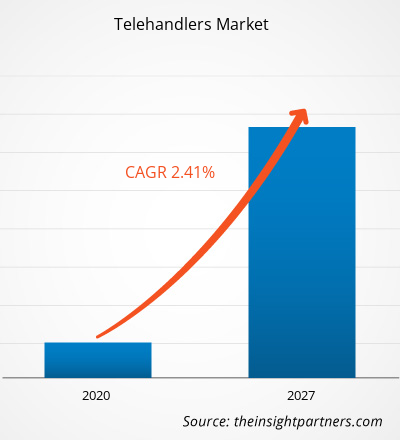[Forschungsbericht]Der Markt für Teleskoplader wurde 2019 auf 6,03 Milliarden US-Dollar geschätzt und soll von 2020 bis 2027 mit einer durchschnittlichen jährlichen Wachstumsrate von 2,41 % wachsen und bis 2027 7,31 Milliarden US-Dollar erreichen.
Der Markt für Teleskoplader hat in den letzten Jahren weltweit ein enormes Wachstum erlebt. Faktoren wie die Zunahme von Bergbau-, Landwirtschafts- und Infrastrukturprojekten treiben die Nachfrage nach Baumaschinen, einschließlich Teleskopladern, weltweit an. Hinzu kommen das Aufkommen intelligenter Technologien und die Einführung elektrischer Teleskoplader. Neben der Bauindustrie spielt die Landwirtschaft eine wichtige Rolle bei der Stimulierung der Nachfrage nach Teleskopladern auf dem Markt. Die USA, China, Indien und Brasilien gehören zu den führenden Ländern mit landwirtschaftlicher Tätigkeit. Teleskoplader sind mechanische Geräte, die in unterschiedlichen Branchen wie Bergbau, Forstwirtschaft, Bauwesen und Landwirtschaft eingesetzt werden. Teleskoplader werden vor allem in Nordamerika und Europa stark genutzt, während sie auf dem asiatischen Markt weniger verbreitet sind. In Asien kommen alternative Maschinen wie Minikräne zum Einsatz. Die wirtschaftliche Lage in den asiatischen Ländern hingegen wächst kontinuierlich, was den Teleskopladeranbietern eine Plattform für das Wachstum ihres Marktes in unerschlossenen Schwellenländern bieten könnte.
Markteinblicke: Wachsendes Bergbau- und Baugeschäft
Infrastrukturgetriebenes Wachstum in Ländern wie China hat zu hohem Wirtschaftswachstum und einer steigenden Nachfrage nach Rohstoffen wie Eisenerz, Kohle, Mangan, Kobalt und Kupfer geführt. Die Explorationsaktivitäten nach wichtigen Mineralien und Metallen sind für das allgemeine Wachstum der Bergbauindustrie von entscheidender Bedeutung. Darüber hinaus treiben das Wachstum von Infrastrukturprojekten und die Entwicklung der städtischen Industrie die Nachfrage nach Baumaschinen innerhalb der Bauindustrie an. Aufgrund der weltweit steigenden Zahl an Infrastrukturprojekten steigt der Bedarf an Geräten mit integrierten hochentwickelten Technologien, um ein höheres Produktivitätsniveau zu gewährleisten.
Aufgrund der oben genannten Faktoren wird ein Wachstum des Teleskopladermarktes erwartet.
Passen Sie diesen Bericht Ihren Anforderungen an
Sie erhalten kostenlos Anpassungen an jedem Bericht, einschließlich Teilen dieses Berichts oder einer Analyse auf Länderebene, eines Excel-Datenpakets sowie tolle Angebote und Rabatte für Start-ups und Universitäten.
Markt für Teleskoplader: Strategische Einblicke

-
Holen Sie sich die wichtigsten Markttrends aus diesem Bericht.Dieses KOSTENLOSE Beispiel umfasst Datenanalysen, die von Markttrends bis hin zu Schätzungen und Prognosen reichen.
Die COVID-19-Pandemie (Coronavirus) 2019/20 hatte erhebliche Auswirkungen auf die Gesellschaft, die öffentliche Gesundheit und die Wirtschaft insgesamt. Darüber hinaus verursachte sie Chaos in zahlreichen Branchen wie dem Baugewerbe, der Fertigung und dem Bergbau. Um die Ausbreitung des Virus zu stoppen, ergreifen mehrere Unternehmen Maßnahmen, um die Sicherheit und das Wohlbefinden ihrer Mitarbeiter zu gewährleisten. Bauprojekte wurden während des Covid-19-Ausbruchs auf Eis gelegt. Auch die Fertigungsindustrie hat ihre Anlagen aufgrund von Lockdowns geschlossen. So hat beispielsweise JLG Industries die Produktion in den USA und Frankreich eingestellt, während in China und Rumänien die Anlagen mit eingeschränkter Belegschaft in Betrieb sind. Stillstände oder eine Produktion mit geringer Kapazität sind die Hauptfaktoren, die sich weiter auf die betroffenen Endverbraucherbranchen wie das Baugewerbe auswirken und letztendlich zur Einführung von Teleskopladern führen werden.
Einblicke in Typen
Basierend auf dem Typ ist der Teleskopladermarkt in kompakte Teleskoplader, Teleskoplader mit hoher Hubhöhe und Teleskoplader mit hoher Last segmentiert. Das Segment der Teleskoplader mit hoher Hubhöhe eroberte einen dominierenden Anteil am globalen Teleskopladermarkt. Die wachsenden Bau- und Bergbauaktivitäten weltweit erfordern den Einsatz von Teleskopladern mit hoher Hubhöhe, um die Gesamtabläufe durch das Heben schwerer Lasten in große Höhen zu rationalisieren. Diese Teleskoplader werden auch in den Bereichen Bau, Fertigung, Lagerhaltung, Bergbau und Steinbruch eingesetzt.
Einblicke in Antriebstypen
Der Teleskopladermarkt ist nach Antriebstyp in Hybrid-, Verbrennungs- und Elektroantrieb segmentiert. Das Segment der Verbrennungsantriebe eroberte einen dominierenden Anteil am globalen Teleskopladermarkt. Teleskoplader mit Verbrennungsmotoren können mit verschiedenen Kraftstoffen betrieben werden, beispielsweise Benzin, Flüssiggas (LPG), Diesel und komprimiertes Erdgas.
Einblicke in die Hubkapazität
Basierend auf der Hubkapazität ist der Markt für Teleskoplader in unter 3 Tonnen, 3 – 10 Tonnen und über 10 Tonnen unterteilt. Das Segment 3 – 10 Tonnen hat einen dominierenden Anteil am globalen Teleskopladermarkt. Die Teleskoplader sind dank des RFID-Systems, das automatisch dynamische Lastdiagramme erstellt, mit einer breiten Palette an Zubehör kompatibel, um die zahlreichen Anforderungen im Fertigungs- und Bausektor zu erfüllen.
Einblicke in die Hubhöhe
Der Markt für Teleskoplader ist nach Hubhöhe in unter 5 Meter, 5 – 15 Meter und über 15 Meter unterteilt. Das Segment 5 – 15 Meter hat einen dominierenden Anteil am globalen Teleskopladermarkt. Die Teleskoplader mit Arbeitshöhen zwischen 5 und 15 Metern bieten höchste Produktivität und Leistung bei niedrigen Betriebskosten, beneidenswerter Vielseitigkeit, erstklassiger Verarbeitungsqualität und einer großen Auswahl an Anbaugeräten.
Endnutzer-Einblicke
Der Teleskopladermarkt ist nach Endnutzern in Baugewerbe, Landwirtschaft, Bergbau, Forstwirtschaft und andere Branchen unterteilt. Das Baugewerbe hat einen dominierenden Anteil am globalen Teleskopladermarkt. Die wachsende Bauindustrie mit der zunehmenden Entwicklung der Gesundheits-, Sozial- und Bildungsinfrastruktur weltweit erfordert Teleskoplader zum Heben von Lasten.
Unternehmen verfolgen häufig Marktinitiativen und neue Entwicklungsstrategien, um ihre Präsenz weltweit auszubauen und die wachsende Nachfrage zu decken. Diese Strategien sind vor allem in Nordamerika und Europa zu beobachten. Die Akteure im Teleskopladermarkt verfolgen eine Strategie der Expansion und Investitionen in Forschung und Entwicklung, um ihren Kundenstamm weltweit zu vergrößern und ihren Markennamen global zu behaupten.
Teleskoplader
Regionale Einblicke in den Markt für TeleskopladerDie Analysten von The Insight Partners haben die regionalen Trends und Faktoren, die den Teleskopladermarkt im Prognosezeitraum beeinflussen, ausführlich erläutert. In diesem Abschnitt werden auch die Marktsegmente und die geografische Lage in Nordamerika, Europa, dem asiatisch-pazifischen Raum, dem Nahen Osten und Afrika sowie Süd- und Mittelamerika erörtert.
Umfang des Marktberichts für Teleskoplader
| Berichtsattribut | Einzelheiten |
|---|---|
| Marktgröße in 2019 | US$ 6.03 Billion |
| Marktgröße nach 2027 | US$ 7.31 Billion |
| Globale CAGR (2019 - 2027) | 2.41% |
| Historische Daten | 2017-2018 |
| Prognosezeitraum | 2020-2027 |
| Abgedeckte Segmente |
By Typ
|
| Abgedeckte Regionen und Länder |
Nordamerika
|
| Marktführer und wichtige Unternehmensprofile |
|
Dichte der Marktteilnehmer für Teleskoplader: Verständnis ihrer Auswirkungen auf die Geschäftsdynamik
Der Markt für Teleskoplader wächst rasant. Die steigende Nachfrage der Endverbraucher ist auf Faktoren wie veränderte Verbraucherpräferenzen, technologische Fortschritte und ein stärkeres Bewusstsein für die Produktvorteile zurückzuführen. Mit der steigenden Nachfrage erweitern Unternehmen ihr Angebot, entwickeln Innovationen, um den Bedürfnissen der Verbraucher gerecht zu werden, und nutzen neue Trends, was das Marktwachstum weiter ankurbelt.

- Holen Sie sich die Markt für Teleskoplader Übersicht der wichtigsten Akteure
- Kompakter Teleskoplader
- Hochhub-Teleskoplader
- Hochlast-Teleskoplader
Globaler Markt für Teleskoplader – nach Antriebsart
- Hybrid
- Verbrennungsmotor
- Elektro
Globaler Markt für Teleskoplader – nach Hubhöhe
- Unter 5 Metern
- 5 – 15 Meter
- Über 15 Meter
Globaler Markt für Teleskoplader – nach Hubkapazität
- Unter 3 Tonnen
- 3 – 10 Tonnen
- Über 10 Tonnen
Globaler Markt für Teleskoplader – Nach Gerätetyp
- Bau
- Landwirtschaft
- Bergbau
- Forstwirtschaft
- Sonstige
Teleskoplader-Markt – nach Geografie
-
Nordamerika
- USA
- Kanada
- Mexiko
-
Europa
- Frankreich
- Deutschland
- Italien
- Großbritannien
- Russland
- Übriges Europa
-
Asien-Pazifik
- China
- Indien
- Australien
- Südkorea
- Japan
- Übriger Asien-Pazifik-Raum
-
Naher Osten & Afrika
- Südafrika
- Saudi-Arabien
- VAE
- Übriger Naher Osten und Afrika
-
Südamerika
- Brasilien
- Argentinien
- Übriges Südamerika
Unternehmensprofile
- AB Volvo
- Bobcat Company
- Caterpillar Inc.
- CNH Industrial NV
- Hauloutte Group
- JLG Industries, Inc.
- Komatsu Ltd.
- Liebherr Group
- Manitou BF
- Terex Corporation
- Historische Analyse (2 Jahre), Basisjahr, Prognose (7 Jahre) mit CAGR
- PEST- und SWOT-Analyse
- Marktgröße Wert/Volumen – Global, Regional, Land
- Branchen- und Wettbewerbslandschaft
- Excel-Datensatz
Aktuelle Berichte
Erfahrungsberichte
Grund zum Kauf
- Fundierte Entscheidungsfindung
- Marktdynamik verstehen
- Wettbewerbsanalyse
- Kundeneinblicke
- Marktprognosen
- Risikominimierung
- Strategische Planung
- Investitionsbegründung
- Identifizierung neuer Märkte
- Verbesserung von Marketingstrategien
- Steigerung der Betriebseffizienz
- Anpassung an regulatorische Trends






















 Kostenlose Probe anfordern für - Markt für Teleskoplader
Kostenlose Probe anfordern für - Markt für Teleskoplader